Watch Two Ukrainian Bradleys Outmaneuver Russia’s Mighty T-90M Tank Through transparent Grit
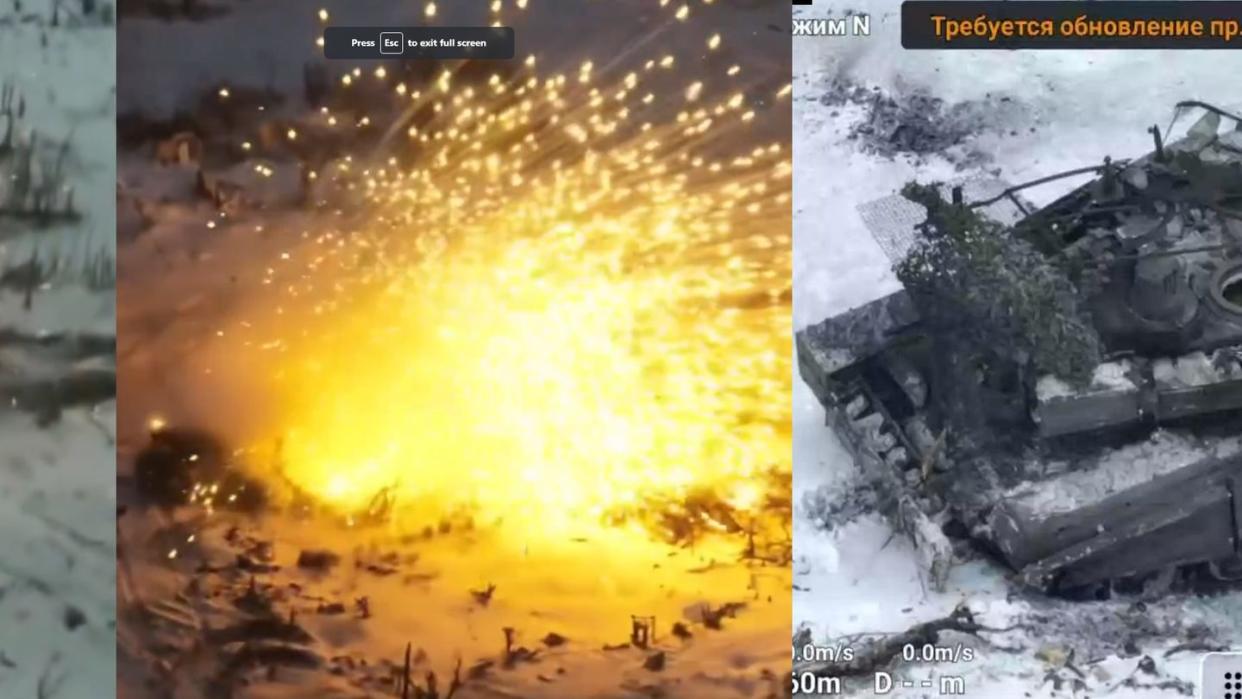
"Hearst Magazines and Yahoo may earn commission or revenue on some items through these links."
The panopticon created by drones and cell phone cameras ubiquitous on Ukrainian battlefields has captured many extraordinary mechanized battles from multiple perspectives.
One of the more curious is a short-range gun fight between two Ukrainian Bradley fighting vehicles and a T-90M tank, which took place on January 11 near a war-torn suburb of Avdiivka called Stepove. An eight-minute black and white video of the fracas was recorded by an overwatching Ukrainian drone and posted to social media. Later, additional footage from a kamikaze drone—along with color footage from another drone—was posted online as well.
A longer video of the two Bradley's engaging on the T-90M can be seen here. pic.twitter.com/VSKkUOnhWE
— NOELREPORTS 🇪🇺 🇺🇦 (@NOELreports) January 13, 2024
On paper, it should have been a hopelessly unequal fight for the Bradleys.
To put it simply, the M2A2 ODS Bradleys each weigh about 30 tons and have 25-millimeter (1”) diameter cannons. The T-90M Proryv-3 (“Breakthrough”), on the other hand, weighs over 51 tons and is armed with a 125-millimeter cannon five times the diameter of the Bradley’s gun.
While Bradleys are unusually tough for infantry fighting vehicles, one would still ordinarily be killed by the T-90M’s massive gun. And though the Bradley’s M242 Bushmaster chain gun fires much more rapidly (up to 3 rounds per second), it simply cannot penetrate the T-90M’s primary frontal armor plates.
The Bushmaster’s standard tungsten M791 armor-piercing discarding sabot/tracer round is rated to penetrate 25 millimeters of RHA equivalent steel at a 60 degree angle at.8 miles range—adequate for chewing up BMP armored vehicles. It can also employ the fin-stabilized depleted uranium M919 round, which boosts penetration to somewhere between 50 and 100 millimeters (though whether Ukraine received such ammunition is unclear).
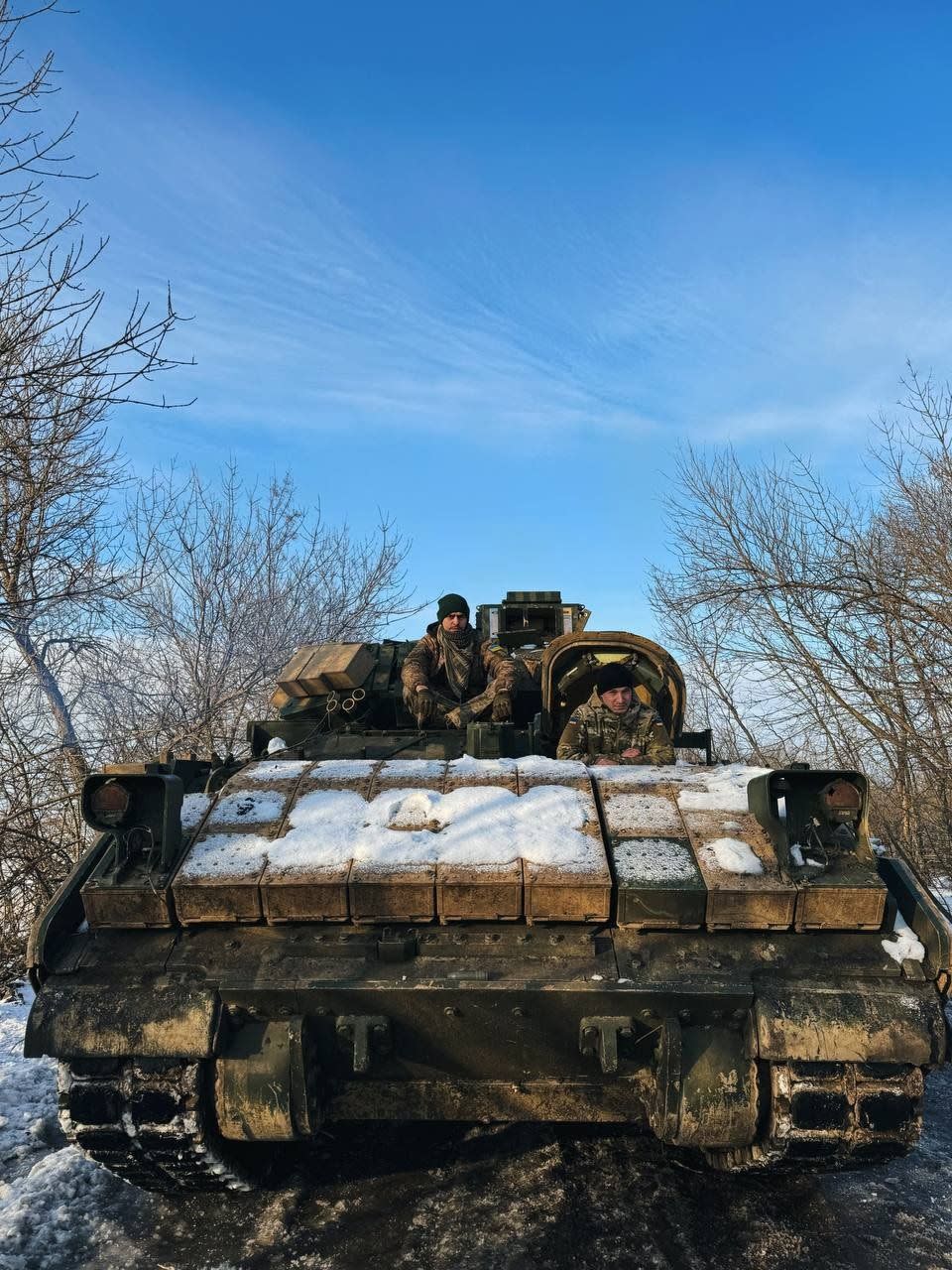
But a T-90M’s front armor supposedly ranges from 750 to 950 millimeters versus kinetic attacks. And its side armor? 200 millimeters.
Game over, then, for the Bradleys? Not necessarily. A tank’s armor is designed to protect its crew and ammunition from shells penetrating the turret or hull—but it doesn’t shield externally-mounted optics, the main gun, or the tracks.
The battle unfolded down a snow-covered lane between the houses inside Stepove itself, with a Bradley advancing perpendicular to the lane. It conducted a ‘drive by’ shooting of the T-90M, raking it multiple times while its stabilized turret continually traversed to stay on target. Some of the 25-millimeter shells exploded on contact, other ricocheted off into the sky.
The T-90M’s gun fired back twice and missed, the second shell landing short of the Bradley as it passed at point blank range. Two minutes in, the T-90s crew released a flashy pattern of smoke brigades as they attempted to make an escape, but seemed disoriented and did not make much progress doing so.
But then, a second Bradley rolled in and raced back to the lane occupied by the T-90M, hammering its exposed side and rear hull repeatedly with autocannon shells for several minutes.
At 5:15 a shell—or possibly a small fire caused by earlier impacts—apparently detonated one of the T-90M’s explosive reactive armor panels, causing a spectacular external explosion.
The second Bradley apparently had just two of the usual three crew: a driver named Oleksandr, and a commander (also doing the gunner’s job) named Serhiy. Amazingly, this was only their second-ever combat mission on the Bradley—Serhiy only completed his Germany-based training in December.
In an interview, Serhiy explained he had an “issue” with the armor-piercing rounds (perhaps meaning they couldn’t penetrate, or were running out). In response, he switched to high-explosive rounds and “blinded” the T-90M. He said he learned from video games “how to hit [tanks] and where.”
A more personal and detailed interview with the crew of the Ukrainian Bradley which took on a russian T-90M. Also goes over using American-supplied Bradley IFVs in conditions of the Ukrainian winter 💪 pic.twitter.com/GtSGt8Cxiq
— WarTranslated (Dmitri) (@wartranslated) January 19, 2024
This is likely a reference to World of Tanks, which is wildly popular in both Russia and Ukraine.
The numerous non-penetrating hits likely knocked out the tank’s expensive thermal optics, damaged its track, and likely did no favors for the crew’s nerves. But something must have eventually caused internal damaged, as a hydraulic or control system breakdown caused the T-90M’s turret to rotate uncontrollably before slamming into a tree.
Finally, a Ukrainian first-person-view kamikaze drone piloted by the 47th Brigade’s drone strike company (or RUBaK) vectored in on the wounded tank. Footage from its camera shows how its operator maneuvered it to approach from the T-90M’s side as to avoid the anti-drone ‘cope cage’ on the top turret. It slammed into the into the T-90M’s vulnerable side armor to detonate what was likely a shaped-charge anti-tank rocket-propelled grenade mounted on it nose.
The T-90M was struck by an FPV after the engagement with the Bradleys. 3/https://t.co/MA2zhZHMcn pic.twitter.com/FvArbmj3Oq
— Rob Lee (@RALee85) January 14, 2024
External footage shows that the drone attack finally caused an internal fire to begin gushing out of the hull’s turret ring. The T-90M lurched a few more feet forward before grinding to a permanent halt. Its three-man crew bailed out, their frantic escape recorded by the overhead drone. The driver (or, some claim, the entire crew) was reportedly captured afterwards by Ukrainian forces.
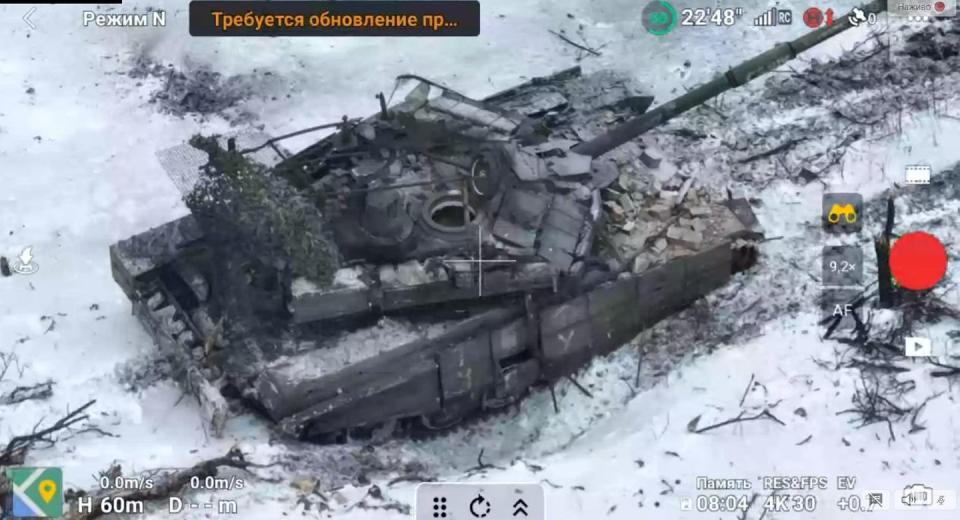
Curiously, the Bradley crews don’t employ TOW anti-tank missiles in the battle—weapons extensively used by U.S. Army Bradley to destroy Iraqi tanks in the 1991 Gulf War and the 2003 invasion of Iraq. Perhaps the 47th’s Bradley didn’t have TOWs loaded, or the crews judged that the conflict was at too close range, as TOWs are less accurate at close range and flat-out won’t work against targets closer than 70 meters. The Bradley’s crew would also have had to stop moving to launch the wire-guided TOW, which might have been deemed too risky.
Takeaways from the Bradley versus T-90M battle
The T-90M is the most advanced Russian tank in service in Ukraine, save for a handful of T-14 tanks briefly combat-tested in 2023. Unlike the T-90A and T-72B3M, the T-90M sports reinforced conventional armor, improved Relikt explosive reactive armor, Shtora and Arena-S active protection systems, moderately safer ammunition storage, a new 2A46M-5 main gun capable of firing more powerful armor-piercing shells, and an uprated 1,130 horsepower diesel engine.
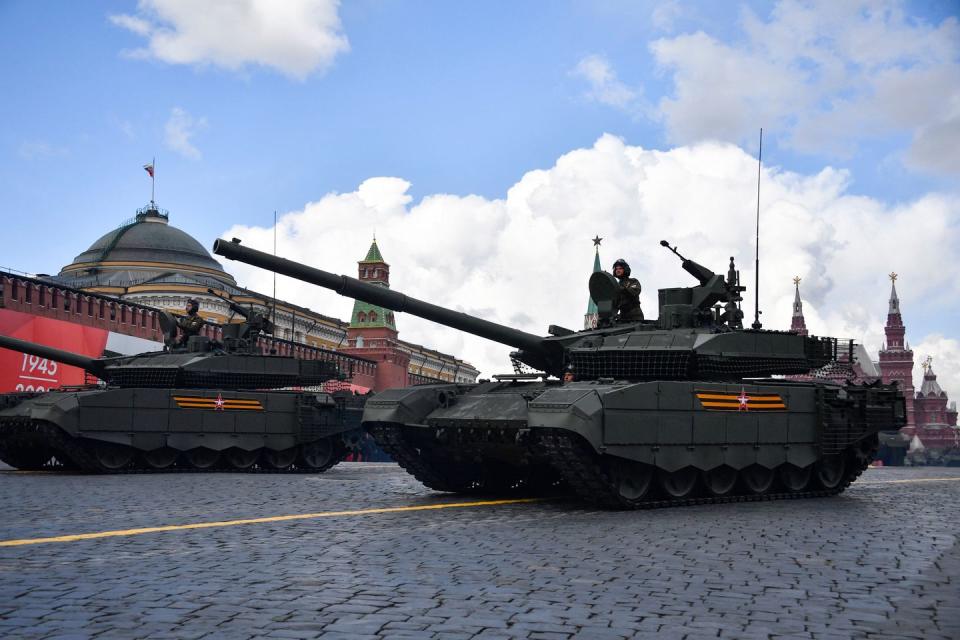
The Bradleys are infantry fighting vehicles designed to carry infantry squads into battle while providing fire support against soft targets and lightly armored vehicles (ie. not tanks). The retired M2A2 ODS (Operation Desert Storm) models that the U.S. gave Ukraine were up-armored (including with explosive reactive armor bricks) more than 30 years ago for combat with Iraq in the 1991 Gulf War.
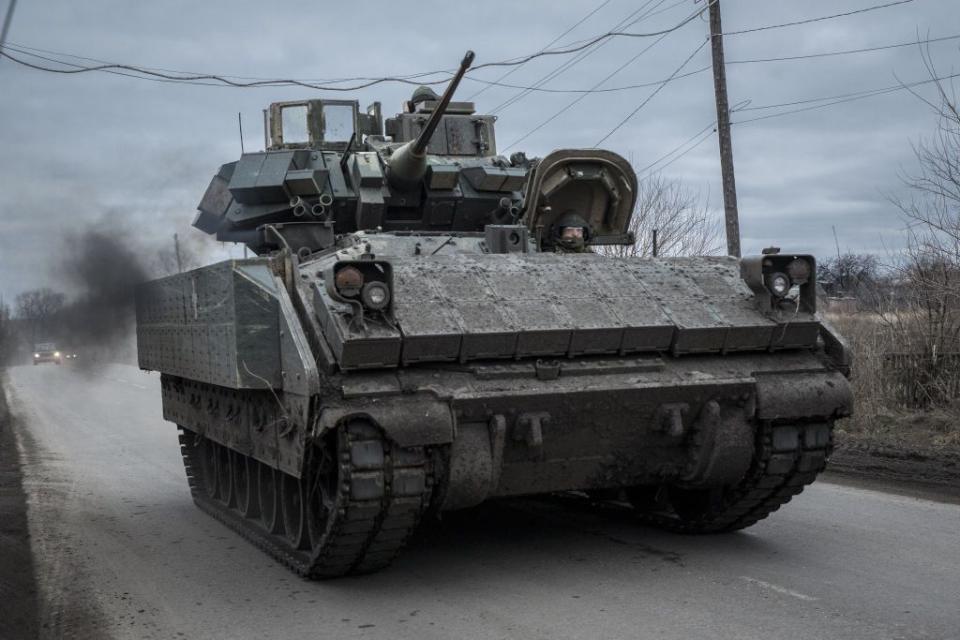
This remarkable engagement doesn’t show that T-90M’s aren’t tough and formidable, but rather highlights the role of crew skill and the complex factors affecting outcomes in armored warfare.
First of all, the Bradley crew’s ability to cooperatively and accurately engage the T-90M despite lacking their third crew member—and their courage to willingly engage such a superior opponent—reflected well on their esprit de corps and training. The 47th Brigade has accumulated extensive experience since its very rough combat debut in June of 2023, though Serhiy and Oleksandr themselves were relatively new to mechanized operations.
While Ukraine has lost roughly one-sixth of the 186 Bradleys it received from the U.S. (with another sixth damaged in combat), the vast majority of those crews survived to carry on their combat experience—thanks in part to better armor protection than Soviet BMP vehicles.
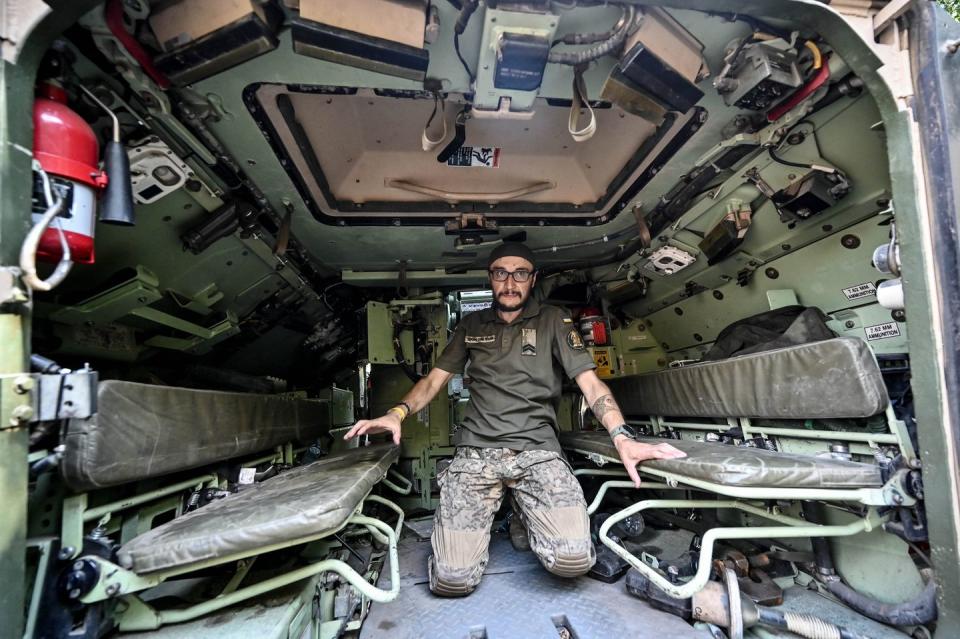
At the same time, the effectiveness of the Bradley’s guns highlights that fact that having thick armor plating doesn’t always protect key systems that the tank needs to move, see, and shoot from non-penetrating hits. Immobilizing hits in particular have resulted in losses of even beefier Western Challenger 2 and Leopard 2 tanks, particularly to mines and artillery. And in this war, immobilized vehicles are more likely than ever to get finished off, due to the saturation of aerial surveillance combined with smart artillery shells and kamikaze drones.
IFVs have damaged or driven away tanks with their autocannons before. During the 1991 Gulf War, Bradleys reported that their depleted uranium rounds could be effective against older Soviet tanks at short range. A video from Ukraine in 2014/2015 shows a Russian BMP battering a Ukrainian T-64 with non-penetrating 30-millimeter hits, compelling it to withdraw. Two combat recordings from Mariupol in 2022 show Ukrainian-built BTR-4E infantry vehicles pummeling Russian tanks with the same guns without receiving effective return fire.
Video from the Azov regiment showing BTR-4 30mm cannon fire on Russian BTR-82A and a T-72B3 tank presumably in Mariupol. Note how they target the tank’s tracks. pic.twitter.com/qPhMTz0670
— Rob Lee (@RALee85) March 20, 2022
A Ukrainian BTR 4 fires on two Russian tanks (possibly T-72s) in Mariupol pic.twitter.com/W83JBICXyU
— OSINTtechnical (@Osinttechnical) April 7, 2022
Do such feats indicate that the tank is dead (as analysts have repeatedly claimed since its combat debut in 1916), and that there’s little point to heavier armor and big main guns?
Not so fast. Despite the battle’s outcome, the T-90s armor still worked to prevent the Bradley’s shells from penetrating, as demonstrated by the crew still being alive and the lack of internal fires prior to the kamikaze drone strike. Thought that’s not exactly impressive against a much smaller gun, it does reflect the fundamental appeal of heavy armor. On the T-90Ms, that armor has decent odds of withstanding hits from older anti-tank missiles and main battle tank shells, as well as near misses from heavy artillery.
Decent odds, but far from perfect. 32 T-90Ms have been visually confirmed destroyed, and another 16 have been seen abandoned or captured since the conflict began by mid-January of 2024 (by the count of the Oryx blog).
Military analyst Rob Lee observed on social media that his takeaway from the fight is that infantry fighting vehicles “can successfully engage and seriously damage modern main battle tanks. [But] that T-90M took 20+ 25mm rounds to its frontal armor and an FPV [kamikaze drone] strike, and the entire crew survived. An infantry fighting vehicle or armored personnel carrier would have not been as lucky.”
Furthermore, small rapid-fire autocannons lose energy (and thus, accuracy) more quickly over longer distances than big shells do, making tanks more effective at such ranges. To be fair, in that situation, a Bradley would fight back with its TOW missiles (if available) which can bust main battle tanks. However, the T-90M’s Relikt explosive reactive armor and active protection systems might succeed in fending off a TOW. (Ukrainian sources have reported that reactive armor and infrared countermeasures can defeat a significant percentage of anti-tank missiles.) Meanwhile, a single penetrating hit from a tank’s armor piercing shells is likely to destroy any infantry fighting vehicle at any range.
In effect, the close combat between the Bradleys and T-90M put both outside their ‘comfort zones’ of optimal use. But the Ukrainian Bradleys—perhaps aided by tips from the over-watching drones—were able to retain the initiative and fight a running battle that overwhelmed their tougher foe psychologically and technically.
You Might Also Like

